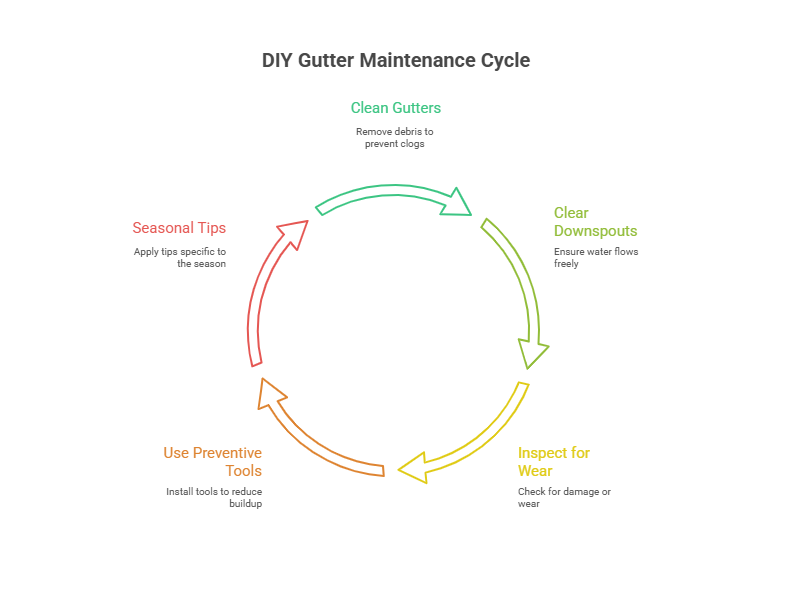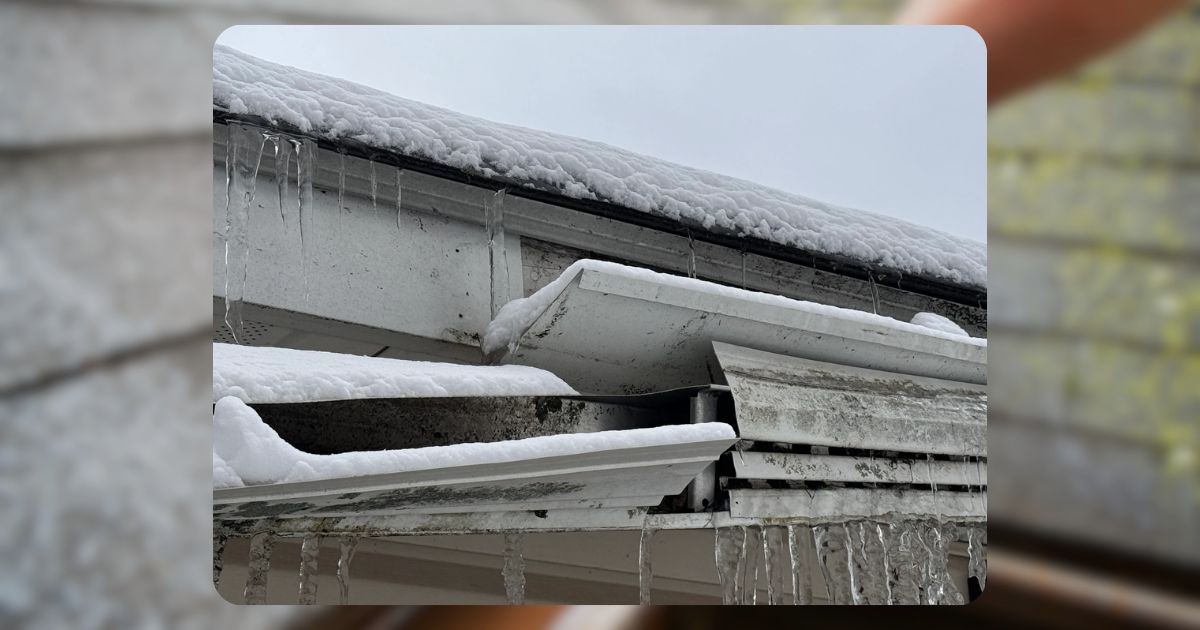Gutters play a key role in protecting your home from water damage. For Connecticut homeowners, keeping them clean is even more important because of heavy fall leaves, snow, and spring rain. Without regular maintenance, gutters can clog, overflow, and lead to roof leaks, foundation cracks, and damaged landscaping.
The good news is that you can handle most gutter care yourself with simple tools and a little time. This guide will walk you through clear, DIY maintenance tips to help you keep your gutters working smoothly through every Connecticut season. Let’s get started.

Table of Contents
#1 Clean Gutters Regularly to Prevent Clogs
In Connecticut, fall leaves, spring rain, and winter snow can quickly fill your gutters with debris. Cleaning them regularly is the best way to prevent clogs and avoid water damage to your roof, walls, or foundation. A quick cleaning at least twice in the fall and once in spring makes a big difference.
Here’s a simple step-by-step process:
- Set up safely: Wear gloves and use a sturdy ladder placed on level ground. Lay a tarp or bucket below to collect debris.
- Scoop out debris: Start near the downspouts. Use your hands or a gutter scoop to remove leaves, twigs, and mud.
- Work in sections: Move carefully along the gutter, clearing each section as you go. Avoid pushing debris toward the downspouts.
- Clean up below: Drop the debris onto the tarp or into the bucket for easy disposal later.
- Flush with water: Use a garden hose to rinse out any remaining dirt and check that water flows smoothly through the gutters.
Regular cleaning keeps gutters clear, reduces the risk of overflow, and helps your home handle Connecticut’s tough weather.
#2 Check and Clear Downspouts
Once your gutters are clean, the next step is to make sure the downspouts are clear. Even if the gutters look good, a clogged downspout can cause water to back up, overflow, or pool near your home’s foundation — a risk you don’t want.
Here’s how to check and clear them:
- Test water flow: Run a garden hose into the gutter opening near the downspout. Watch if water flows freely out the bottom.
- Check for clogs: If the water backs up or trickles out, you likely have a clog inside.
- Clear the blockage: Use a plumber’s snake or a long stick to loosen the clog from the bottom or top. For stubborn clogs, you can use the hose on high pressure to push debris through.
- Ensure proper drainage: Make sure the downspouts direct water at least 3–4 feet away from your home’s foundation using extensions or splash blocks.
By keeping downspouts clear, you help the whole system work as it should.
#3 Inspect for Signs of Wear During Maintenance
While you’re already up there cleaning, take a moment to check the condition of your gutters. Spotting small issues early can save you from bigger, costly problems later.
Here’s what to look for:
- Check for cracks or holes: Look along the gutter line for small cracks, rust spots, or pinholes where water could leak through.
- Look at fasteners and hangers: Make sure the screws or brackets holding the gutters are tight and not pulling away from the house.
- Check for sagging or uneven sections: Gutters should have a slight slope to guide water to the downspouts. If they’re sagging, water can pool and spill over.
- Inspect sealant areas: At gutter joints or seams, check if sealant is worn or peeling.
By adding this quick check to your cleaning routine, you can catch damage early and handle simple fixes before they turn into expensive repairs.
#4 Use Preventive Tools to Reduce Future Buildup
Once your gutters are clean and checked, it’s smart to take steps that cut down on future debris. Preventive tools save you time and lower the need for constant cleaning, especially in Connecticut’s leaf-heavy fall season.
Here’s what helps:
- Install gutter guards or screens: These cover the top of the gutters and block most leaves and twigs while still letting water in. They’re especially useful under large trees.
- Add downspout strainers: These small metal or plastic baskets fit into the top of the downspout opening and catch debris before it clogs the pipe.
- Trim overhanging branches: Cut back trees and bushes hanging over your roof to reduce the amount of leaves and sticks falling into the gutters.
- Check regularly anyway: Even with guards, it’s smart to give your gutters a quick look every few months to make sure nothing slipped through.
Taking these small steps keeps your gutters clearer for longer and makes seasonal maintenance much easier.
#5 Seasonal Tips for Connecticut Homeowners
Connecticut’s changing seasons bring different gutter challenges, so it’s smart to adjust your maintenance throughout the year. A little planning each season keeps your gutters in good shape and helps avoid sudden problems.
Here’s what to focus on:
- Fall: Clean gutters at least twice — once mid-season, once after most leaves have fallen. Watch for heavy leaf buildup and remove it before snow arrives.
- Winter: Check gutters after snowstorms. Use a roof rake to clear heavy snow near the edge and prevent ice dams. Make sure gutters aren’t weighed down by ice.
- Spring: After big rains, inspect for any clogs, leaks, or damage caused by winter weather. Flush the gutters well to clear out leftover grit and pollen.
- Summer: Do a quick check for dry leaves, twigs, or signs of small plants growing in the gutters. Remove nests or debris and get ready for the coming fall.
By staying in tune with the seasons, you keep your gutter maintenance light and manageable.
Conclusion
DIY gutter maintenance isn’t just about avoiding clogs — it’s about protecting your home, your time, and your wallet. A clean, working gutter system reduces the risk of water damage, extends the life of your roof and foundation, and even helps preserve your landscaping.
By keeping up with these small, regular tasks, you avoid surprise repairs and keep your home ready for Connecticut’s demanding weather. More importantly, you stay in control, saving money and stress down the line. A few hours each season can give you peace of mind that lasts all year




